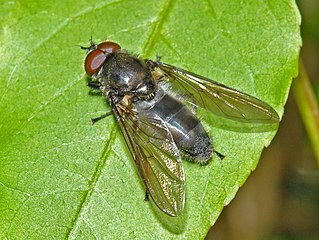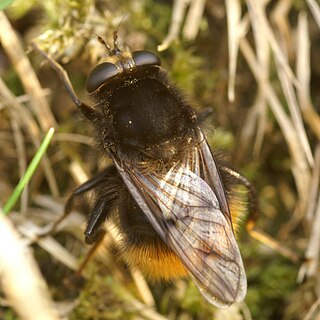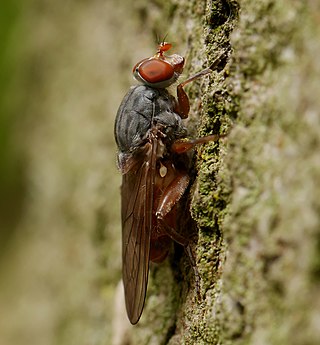
Hoverflies, also called flower flies or syrphids, make up the insect family Syrphidae. As their common name suggests, they are often seen hovering or nectaring at flowers; the adults of many species feed mainly on nectar and pollen, while the larvae (maggots) eat a wide range of foods. In some species, the larvae are saprotrophs, eating decaying plant and animal matter in the soil or in ponds and streams. In other species, the larvae are insectivores and prey on aphids, thrips, and other plant-sucking insects.

Myathropa florea, sometimes referred to as the Batman hoverfly, is a very common European and North African species of hoverfly. Adults may be seen on flowers from May to September. It is of a similar size to the common drone fly, but Myathropa are generally more yellow, with two light bands to the thorax, interrupted with a black central smudge. In museum specimens, any yellow colour soon fades to brown after death. Like most species in the tribe Eristalini, Myathropa are rather variable in size, shape and colour.

Leucozona glaucia, the Pale-saddled Leucozona is a Palearctic hoverfly. Larvae feed on ground layer aphids. Adults are usually seen visiting flowers.

Dasysyrphus venustus is a Holarctic species of hoverfly.

Baccha elongata is a species of hoverfly in the genus Baccha.

Xanthandrus comtus is a species of hoverfly. It is found in the Palearctic.

Cheilosia variabilis, common name figwort cheilosia, is a species of hoverfly belonging to the family Syrphidae.

Milesia is a genus of very large hoverflies, which mimic social wasps. For example, the European species Milesia crabroniformis is a convincing mimic of the hornet species Vespa crabro. Milesia are predominantly Palaeotropical in distribution almost entirely Oriental.

Fagisyrphus cinctus is a European species of hoverfly. This species has a muddled taxonomic history. Older authors treated it as a member of the genus Melangyna, and later sources in Meligramma, but the most recent sources recognize it as the sole species in its own monotypic genus, Fagisyrphus.

Syrphus torvus, the Hairy-eyed Flower Fly, is a common species of hoverfly found in the Holarctic. The adults feed on pollen and nectar, but the larvae feed on aphids.

Pipiza luteitarsis is a species of Hoverfly, from the family Syrphidae, in the order Diptera.

Criorhina floccosa, is a species of hoverfly. It is found in many parts of the Palearctic including Europe.

Criorhina ranunculi, is a species of hoverfly found in the spring in many parts of Britain and Europe.
Platycheirus europaeus is a Palearctic species of hoverfly. It is found in many parts of Europe and eastern Asiatic Russia The habitat is brook floodplains and wet flushes in montane grassland and beside streams or flushes in forest in the Carpinus and Quercus zone up into the Fagus and Picea/ Pinus zone. Flies among grasses from May to August. Flowers visited include Graminae and Cyperaceae, Ranunculus, Taraxacum.

Sphegina elegans is a species of hoverfly.

Brachypalpoides lentus is a European species of hoverflies.

Brachyopa bicolor (Fallén, 1817) is an uncommon species of syrphid fly. It has been observed in Central Europe from Germany to Greece. Hoverflies get their names from the ability to remain nearly motionless while in flight. The adults are also known as flower flies for they are commonly found around and on flowers, from which they get both energy-giving nectar and protein-rich pollen. Larvae for this genus are of the rat-tailed type. B.bicolor larvae have been described from sap runs in Aesculus, Fagus and Quercus.

Brachypalpus valgus is a species of hoverfly found in Europe.

Mallota cimbiciformis is a Palearctic hoverfly.

Caliprobola speciosa is a Palearctic hoverfly. It is an ancient woodland bioindicator.





















